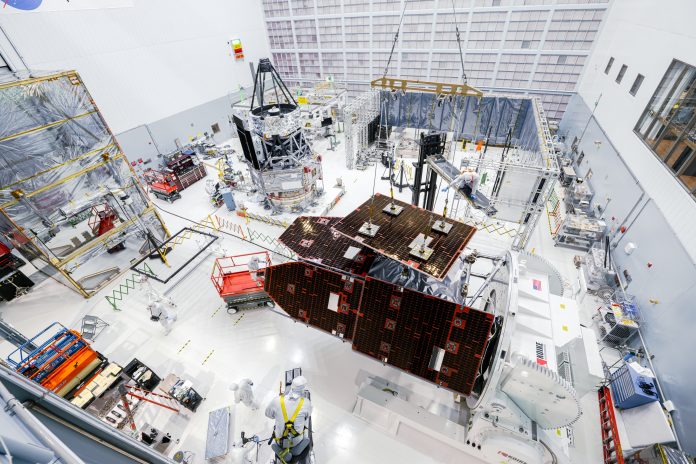NASA has reached a massive milestone in the construction of the NASA Grace Roman Space Telescope, making it closer to the launch of one of its most advanced space observatories
On June 14 and 16, technicians successfully installed the Grace Roman Space Telescope’s Solar Array Sun Shield, which is an essential component that will power and cool the spacecraft during its mission to explore the universe in infrared light.
The Solar Array Sun Shield is made up of six solar panels, all of which have solar cells. Two central panels are fixed to the telescope’s outer shell, while the remaining four are designed to deploy once the telescope reaches space. These panels will orient themselves to face the Sun at all times, ensuring a constant supply of power for the spacecraft’s electronics.
This configuration also creates protection. By shading much of the observatory, the panels help keep its sensitive instruments cool. Since the Grace Roman Space Telescope observes in infrared, it must avoid warming itself. Any excess heat from its systems could interfere with its observations, reducing the mission’s scientific accuracy.
Final stages of assembly
The recent installation marks one of the final steps in assembling the observatory. The outer portion of the Grace Roman Space Telescope is now complete, and the team will conduct tests soon to ensure all systems function as intended. These include a test deployment of both the solar panels and the deployable aperture cover, often referred to as the “visor.”
The core part of the telescope is undergoing extensive evaluation. Engineers are assessing the spacecraft’s electronics and running thermal vacuum tests that simulate the extreme environment of space. These tests are essential for verifying the observatory’s performance and reliability once it is launched.
An early launch
With the observatory now about 90% complete, the next significant milestone is the integration of Roman’s inner and outer assemblies. Scheduled for November, this step will unite the Grace Roman Space Telescope into a single, entirely constructed observatory by the end of the year.
NASA originally set a launch deadline of no later than May 2027, but progress has been ahead of schedule. The current target is now fall 2026, several months earlier than initially promised. Once completed and thoroughly tested, the telescope will be prepared for launch aboard a yet-to-be-announced rocket.
A joint mission
The Grace Roman Space Telescope is being developed and managed at NASA’s Goddard Space Flight Centre in Greenbelt, Maryland. The project includes key collaborations with NASA’s Jet Propulsion Laboratory in Southern California, Caltech/IPAC in Pasadena, the Space Telescope Science Institute in Baltimore, and a vast network of scientists from various research institutions.
Industrial partners supporting the mission include BAE Systems Inc. in Boulder, Colorado; L3Harris Technologies in Rochester, New York; and Teledyne Scientific & Imaging in Thousand Oaks, California. These organisations contribute crucial engineering and technological expertise to ensure the telescope performs its complex scientific mission.
Once launched, the Grace Roman Space Telescope will open a new chapter in space science. It is designed to investigate dark energy, exoplanets, and the structure of the universe, building on the legacy of the Hubble and James Webb space telescopes.











